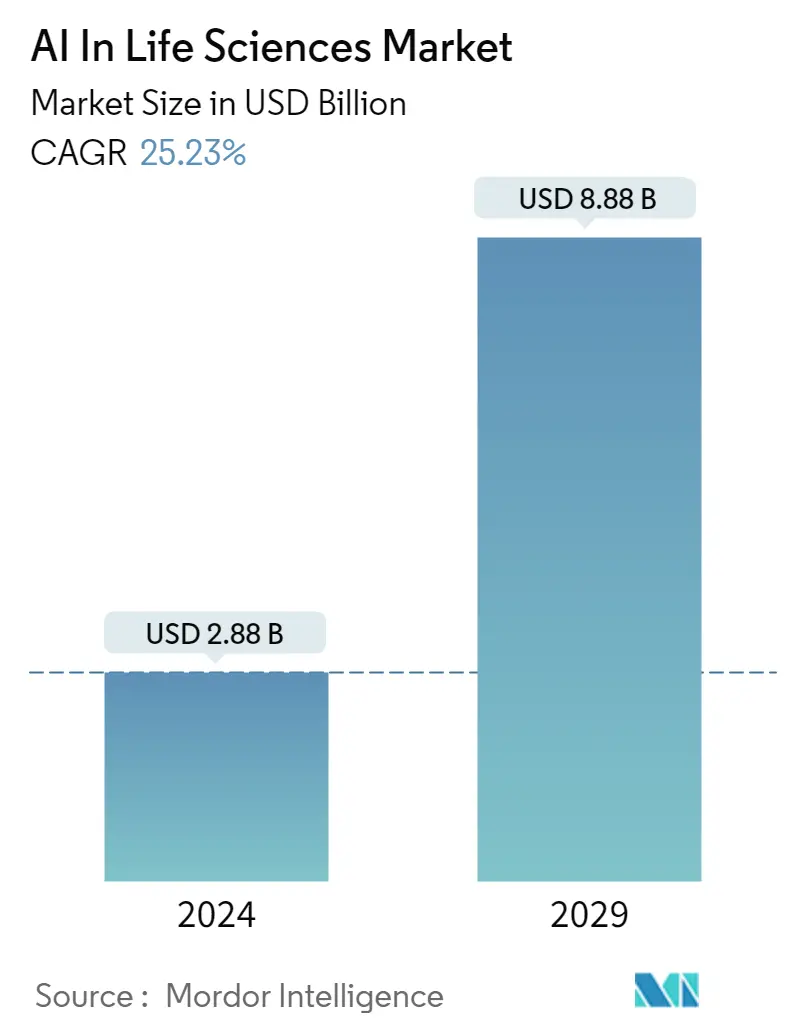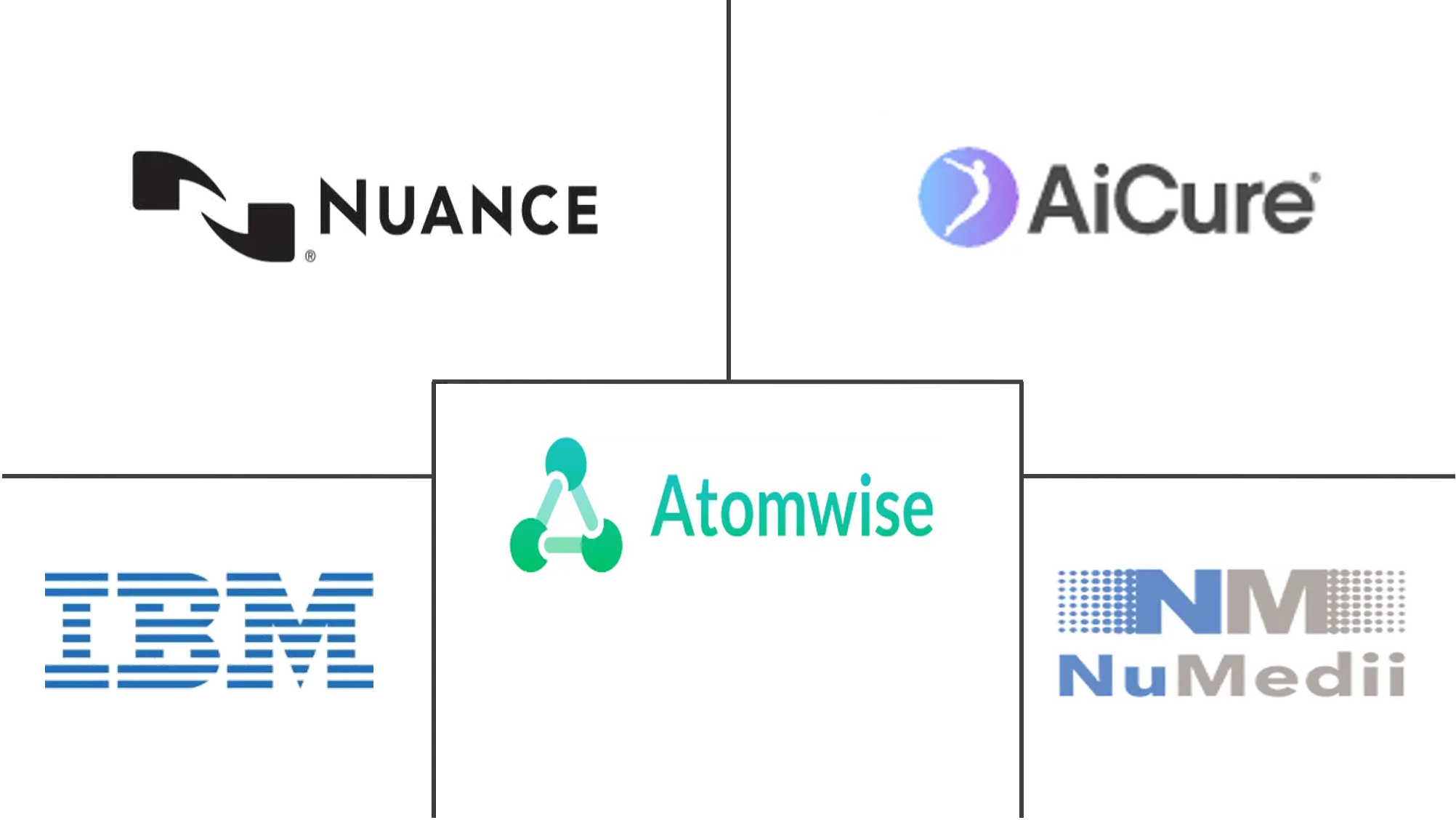Market Size of AI In Life Sciences Industry

| Study Period | 2019 - 2029 |
| Market Size (2024) | USD 2.88 Billion |
| Market Size (2029) | USD 8.88 Billion |
| CAGR (2024 - 2029) | 25.23 % |
| Fastest Growing Market | Asia Pacific |
| Largest Market | North America |
| Market Concentration | Medium |
Major Players
*Disclaimer: Major Players sorted in no particular order |
AI in Life Sciences Market Analysis
The AI In Life Sciences Market size is estimated at USD 2.88 billion in 2024, and is expected to reach USD 8.88 billion by 2029, growing at a CAGR of 25.23% during the forecast period (2024-2029).
The COVID-19 outbreak has made profound and lasting impacts on the health and life sciences industry. The outbreak has caused life sciences organizations to adjust to supply chain and clinical development disruptions and financial challenges that would have previously been unthinkable. In the near term, healthcare organizations will accelerate innovation to respond to the crisis. These investments would enable healthcare organizations post-COVID-19 to rethink care delivery and financing, thereby stimulating the growth in the adoption of AI for the life sciences industry.
- Further, the industry is witnessing a transformation owing to increasing cost pressure, a greater need for productivity, and disruption caused by new and innovative market players. An emerging area of artificial intelligence (AI), specifically the analysis of small systems-of-interest-specific datasets, can be utilized to improve drug development and personalized medicine.
- According to a study published in Science Translational Medicine, Quadratic Phenotypic Optimization Platform (QPOP), an AI platform, can substantially improve combination therapy in bortezomib-resistant multiple myeloma, which is used to identify the best drug combinations for individual multiple myeloma patients.
- Furthermore, complex diseases, such as cancer, often require effective drug combinations to make any significant therapeutic impact. As the drugs in these combination therapies become increasingly specific to molecular targets, designing effective drug combinations and choosing the right drug combination for the right patient becomes more difficult. With the high average development costs (around USD 2 billion for a newly approved treatment), low clinical trial drug success rate (below 12%), low return-on-investment (ROI) due to reduced healthcare expenditure, and focus on rare diseases, drug discovery is becoming more inefficient.
- Clinical trial research is extensive progress, which can be reduced with the help of AI in numerous ways. One is using advanced predictive analytics on a broad range of data to quickly identify candidates for clinical trials for target populations. Additionally, machine learning applications can make clinical trials more efficient by facilitating tasks such as calculating ideal sample sizes, facilitating patient recruitment, and using medical records to minimize data errors.
- Artificial Intelligence (AI) presents one of the most promising and potentially transformative opportunities for the life sciences industry. AI will be a key investment target in the coming years, with myriad organizations hoping to capitalize on its potential. The number of applications is expected to continue to increase, and investors are expected to enter the AI industry early.
AI in Life Sciences Industry Segmentation
Artificial intelligence (AI) in the life sciences industry is used for various applications, such as drug discovery, biotechnology, medical diagnosis, clinical trials, precision and personalized medicine, and patient monitoring. The study also categorizes the impact of these applications across various regions. AI is a highly data-driven technology. In the life sciences sector, it is commonly employed to make meaningful relations from loosely coupled data. With the introduction of the third wave of AI, it is anticipated that advanced AI solutions can learn and evolve as they find novel applications. The study also assesses the impact of COVID-19 on the industry.
The Artificial Intelligence in Life Sciences Market is segmented by Application (Drug Discovery, Medical Diagnosis, Biotechnology, Clinical Trials, Precision, and Personalized Medicine, Patient Monitoring) and Geography (North America, Europe, Asia Pacific, Latin America, and Middle East and Africa).
The market sizes and forecasts are provided in terms of value (USD million) for all the above segments.
| Application | |
| Drug Discovery | |
| Medical Diagnosis | |
| Biotechnology | |
| Clinical Trails | |
| Precision and Personalized Medicine | |
| Patient Monitoring |
| Geography | |||||||
| |||||||
| |||||||
| |||||||
| Rest of the World |
AI In Life Sciences Market Size Summary
The AI in Life Sciences market is poised for significant expansion, driven by the need for innovation and efficiency in the wake of challenges posed by the COVID-19 pandemic. The pandemic has prompted healthcare organizations to accelerate the adoption of AI technologies to enhance care delivery and financial strategies. This shift is further fueled by increasing cost pressures and the need for greater productivity within the industry. AI is being leveraged to improve drug development processes and personalized medicine, particularly in complex disease treatment such as cancer. The integration of AI in clinical trials is expected to streamline operations, from patient recruitment to data analysis, thereby addressing inefficiencies in drug discovery and development.
The United States stands as the largest market for AI solutions in life sciences, supported by substantial investments in research and development by pharmaceutical companies. The competitive landscape is characterized by strategic collaborations and acquisitions aimed at enhancing AI capabilities and expanding market reach. Major players are focusing on leveraging AI to optimize drug discovery and development processes, with significant partnerships and investments in AI-driven platforms. The growing availability of clinical trial data and the increasing number of trials worldwide are creating new opportunities for AI applications, particularly in regions like Europe and North America. This trend is encouraging research institutes to adopt AI over traditional methods, further propelling market growth.
AI In Life Sciences Market Size - Table of Contents
-
1. MARKET DYNAMICS
-
1.1 Market Overview
-
1.2 Industry Attractiveness - Porter Five Forces
-
1.2.1 Threat of New Entrants
-
1.2.2 Bargaining Power of Buyers/Consumers
-
1.2.3 Bargaining Power of Suppliers
-
1.2.4 Threat of Substitute Products
-
1.2.5 Intensity of Competitive Rivalry
-
-
1.3 Market Drivers
-
1.3.1 Increasing Adoption of AI in the Domain of R&D
-
1.3.2 High Emphasis on the Development of Precision Medicine and Personalized Drugs
-
1.3.3 Increasing Demand for AI in Drug Discovery
-
1.3.4 Increasing Use of Artificial Intelligence in Clinical Trials
-
-
1.4 Market Restraints
-
1.4.1 High Initial Costs and Concerns over the Replacement of Human Workforce
-
-
1.5 Technology Snapshot
-
1.6 Impact of COVID-19 on the Industry
-
-
2. MARKET SEGMENTATION
-
2.1 Application
-
2.1.1 Drug Discovery
-
2.1.2 Medical Diagnosis
-
2.1.3 Biotechnology
-
2.1.4 Clinical Trails
-
2.1.5 Precision and Personalized Medicine
-
2.1.6 Patient Monitoring
-
-
2.2 Geography
-
2.2.1 North America
-
2.2.1.1 United States
-
2.2.1.2 Canada
-
-
2.2.2 Europe
-
2.2.2.1 Germany
-
2.2.2.2 United Kingdom
-
2.2.2.3 France
-
2.2.2.4 Rest of Europe
-
-
2.2.3 Asia Pacific
-
2.2.3.1 China
-
2.2.3.2 Japan
-
2.2.3.3 India
-
2.2.3.4 South Korea
-
2.2.3.5 Rest of Asia Pacific
-
-
2.2.4 Rest of the World
-
-
AI In Life Sciences Market Size FAQs
How big is the AI In Life Sciences Market?
The AI In Life Sciences Market size is expected to reach USD 2.88 billion in 2024 and grow at a CAGR of 25.23% to reach USD 8.88 billion by 2029.
What is the current AI In Life Sciences Market size?
In 2024, the AI In Life Sciences Market size is expected to reach USD 2.88 billion.

